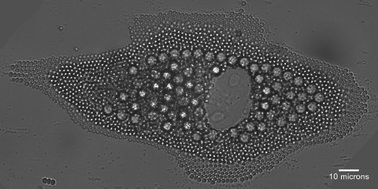Abstract
Many cells ingest foreign particles through a process known as

- This article is part of the themed collection: Cells and proteins at interfaces
* Corresponding authors
a Max Planck Institute for Metals Research, Department of New Materials and Biosystems, Heisenbergstr. 3, Stuttgart, Germany
b Department of Biophysical Chemistry, Institute of Physical Chemistry, University of Heidelberg, Germany
c
As of January 2007: School of Physics, Georgia Institute of Technology, Atlanta, Georgia, USA
E-mail:
jennifer.curtis@urz.uni-heidelberg.de
Many cells ingest foreign particles through a process known as

 Please wait while we load your content...
Something went wrong. Try again?
Please wait while we load your content...
Something went wrong. Try again?
V. K. Kodali, W. Roos, J. P. Spatz and J. E. Curtis, Soft Matter, 2007, 3, 337 DOI: 10.1039/B611022N
To request permission to reproduce material from this article, please go to the Copyright Clearance Center request page.
If you are an author contributing to an RSC publication, you do not need to request permission provided correct acknowledgement is given.
If you are the author of this article, you do not need to request permission to reproduce figures and diagrams provided correct acknowledgement is given. If you want to reproduce the whole article in a third-party publication (excluding your thesis/dissertation for which permission is not required) please go to the Copyright Clearance Center request page.
Read more about how to correctly acknowledge RSC content.
 Fetching data from CrossRef.
Fetching data from CrossRef.
This may take some time to load.
Loading related content
